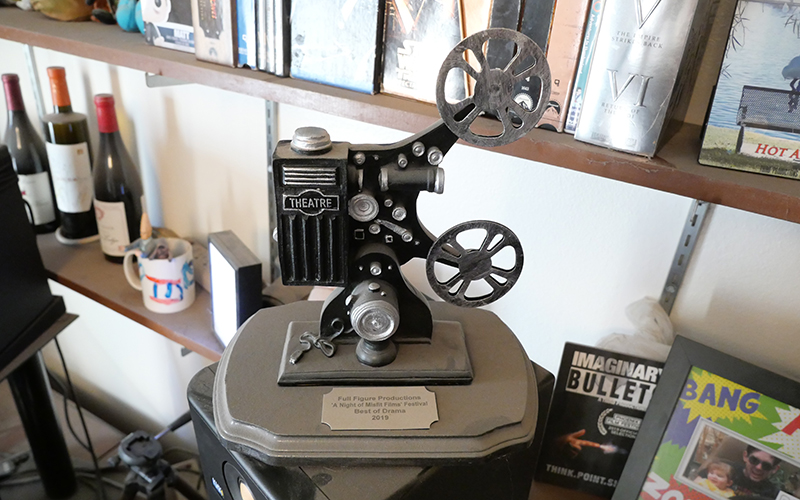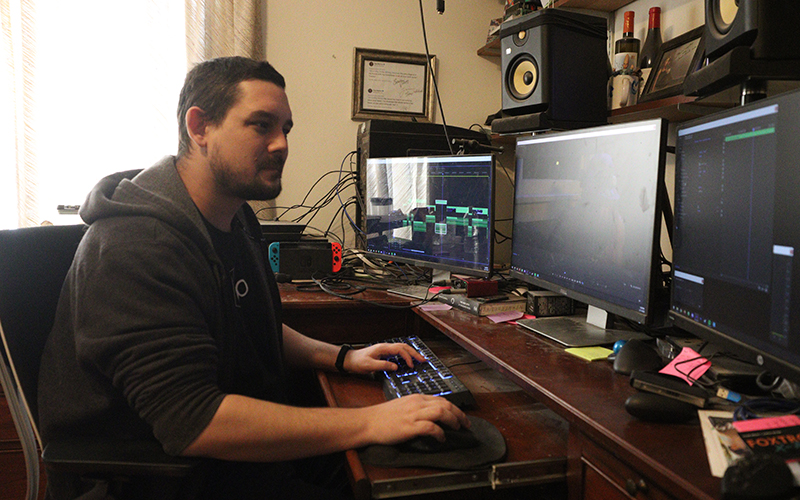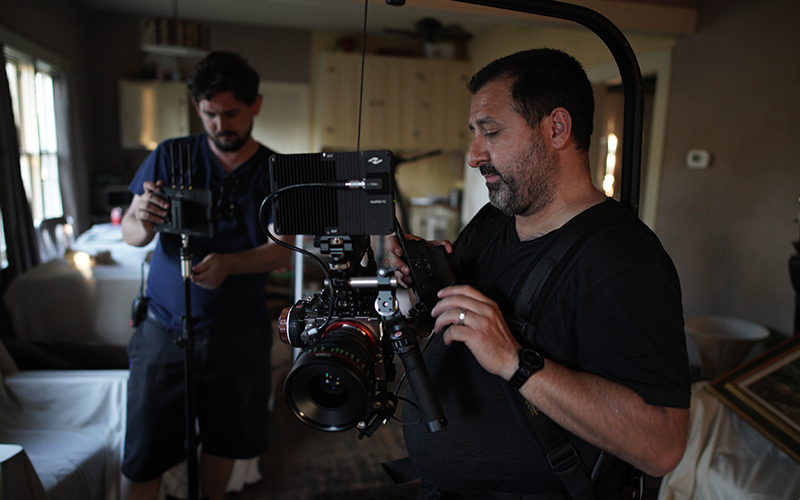MESA – Other than slivers of sunlight seeping through the closed shades, the only light in the home office came from three large computer monitors on a desk that wrapped around a third of the modest-size space. Sean Oliver sat in front of the monitors, editing the first cut of his new independent film.
The mouse zipped from page to page, monitor to monitor, moving so quickly that it was hard to keep track of it. Still, Oliver leaned comfortably in his chair, like a driver who’s perfectly in tune with his race car.
“Forever Home” is Oliver’s first feature-length narrative film, a haunted-house movie he co-wrote and co-produced with a friend during the pandemic. All the preproduction and filming took place in Arizona, which has become fertile ground for independent productions after years of neglect.
Oliver isn’t a big-time filmmaker, or even a full-time filmmaker. He’s an editor, writer and director for Amoroma Productions, which makes commercials, and he takes on the occasional freelance project.
Many local filmmakers are part-timers who mostly work on projects in their free time, or after they’ve secured financial support. Much of the real money to be made in film in the state is in commercials. The market for films that tell stories in a narrative fashion – like “Forever Home” – is very small.
At one point in the 20th century, Arizona was the third most popular film location in the industry, trailing only California and New York. It made a name for itself as the preferred location of Westerns, as far back as 1920, a genre epitomized by John Ford’s “Stagecoach” in 1939, set against the backdrop of Monument Valley, the iconic landscape of the Four Corners area of the Navajo Nation.
In the following decades, productions filmed in the state included “3:10 to Yuma” (1957), parts of “Psycho” (1960) and “Planet of the Apes” (1968), and “Night of the Lepus” (1972). The peak came in the 1980s, with such popular films as “National Lampoon’s Vacation,” parts of “Indiana Jones and the Temple of Doom,” “Bill & Ted’s Excellent Adventure” and “Raising Arizona.” “Thelma & Louise” put the Grand Canyon in full frame in 1991, and “Jerry MaGuire” showed us the money in 1996.
The state’s moviemaking industry sustained itself through tax incentives for locally shot productions until 2010, when the Legislature ended the program in response to the Great Recession. That gave an advantage to New Mexico, a desert state with landscapes similar to Arizona’s, which retained its tax incentives. When the state Senate shut down the Arizona Film Office later that year, the state’s film industry all but died.

Sean Oliver’s best of drama award from A Night of Misfit Films in 2019 rests on a speaker in his office on Nov. 12, 2021. Oliver says he enjoys the freedom that comes from being small and “off the map.” (Photo by Troy Hill/Cronkite News)
In 2016, however, the idea of reviving the film office gained support, and the Arizona Commerce Authority reopened it and hired Matthew Earl Jones to direct it. His goal is to restore Arizona as a go-to destination for the filmmakers.
To do so, Earl Jones – who has worked in the industry for more than 30 years, creating and acting in commercials and music videos – had to rekindle relationships and establish new connections with film production units.
A film office’s main role is to help productions by putting them in contact with potential crew and providing information on local amenities, such as specific locations to shoot, hotels to house cast and crew, and restaurants to cater. This also makes the area more attractive for prospective productions.
In 2016, however, Earl Jones didn’t have much to go with.
“I inherited a hat and a pen, and not much more,” he said.
When Earl Jones – whose half brother is acting legend James Earl Jones – gets on the phone with prospective clients, they often talk about past experiences filming in Arizona and how much they enjoyed working with the people and places in the state.
“It’s not our first time to the dance,” Earl Jones said. “I’ve seen (the industry in Arizona) consistently grow.”
Banking on building strong relationships to revitalize the industry, he has reached across the border, to the Mexican state of Sonora, to offer production companies beach locations that aren’t available in landlocked Arizona. Jones also signed a deal with the Navajo Nation to train Indigenous production crew members to create jobs and attract more economic opportunities in the region.
He regularly pushes Arizona to production companies that are looking for a place to shoot their next movie or TV series. His efforts have paid off: HBO announced plans to shoot “Duster,” a series co-written by J.J. Abrams and LaToya Morgan, in Tucson. The series is expected to bring $65 million into the state.
That’s the big-money stuff, though. Even in the toughest or driest times for filmmaking in Arizona, communities of small in-state filmmakers managed to build their own networks, sustainability and relative success.
In an interview, Oliver, the Mesa-based indie filmmaker, talked about the freedom that comes from being small and “off the map.” Independent filmmakers have greater latitude to make the kind of films they want, such as a Western sci-fi series with vampires, by Michael Flores, which Oliver found among the mostly slice-of-life features in the LA Web Fest two years ago.
“A lot of filmmakers here are like, ‘This is what I want to make. I’m going to make it,’” Oliver said.

Daniel Mendoza, left, the director of photography on “Forever Home,” and Sean Oliver watch the camera as Drew Leatham performs on the set of Oliver’s film “Forever Home” on Oct. 19, 2021. (Photo by Nick Gasmena)
The Phoenix Film Festival has been a significant part of the film industry in the state, giving space and community to small-scale productions. From 2010 to 2016, the festival’s attendance grew even as big-budget filming in the state nearly ground to a halt.
Each year, the festival hosts a competition of Arizona features that usually has at least three films. A few more films are shown out of competition, and the festival includes short film programs. It also provides local filmmakers the opportunity to come together, learn from each other, share ideas and network.
“We have so many stories of people meeting up at our festival and then ending up working together making films in the future and starting businesses,” said Jason Carney, the director of the Phoenix Film Festival. “What we do with the festival is try to breed that networking and that creative community.”
In 2021, the festival named Oliver as the Arizona Filmmaker of the Year. His other awards include a best of drama award at A Night of Misfit Films in 2019 and a few 48-hour festival awards.
“Part of what I like about (the Filmmaker of the Year) award is knowing who it comes from, and that they’re genuinely supportive individuals that have basically watched my career grow over 10 years,” Oliver said. “This is kind of their way of encouraging me to keep growing and keep going. Keep getting better.”
Oliver and his friend wrote “Forever Home” during the pandemic. After raising enough money, in part through a wefunder.com campaign, they entered preproduction – the phase in which cast and crew come aboard and directors and producers prepare all that’s necessary, from meeting schedules to shoot dates to set design, for the film to succeed.
A major development that made the production of “Forever Home” possible were local connections he made in the industry – his bosses at Amoroma Productions, Daniel and Kellie Mendoza. They believed in Oliver’s idea enough to come on as producers, and Daniel acted as director of photography, the role in film production that handles everything to do with the camera and achieving the look desired by the director.
Daniel Mendoza brought all the cinema camera equipment needed for the Oliver’s film, which saved Oliver tens of thousands of dollars in rental costs.
Oliver and his partner cast the roles and brought on enough crew to film the movie. Most of them agreed to help in exchange for little or deferred payment.
They shot the movie in chunks, on different trips to Flagstaff, because everyone involved had full-time jobs needed to pay their bills.
Arizona State University’s recently renamed Sidney Poitier New American Film School has been educating students for more than two decades. Although many have landed jobs in the industry, they’ve often had to leave the state to do so.
The Poitier School is opening a state-of-the-art building in Mesa next year, with four soundstages, multiple editing bays, post production facilities and scene and costume shops.
The school’s associate director, Jason Davids Scott, said he envisions the facility “not only as a place for our students, but a place for the community to come and learn about media making and moviemaking.”
During summers, school officials hope to use the building to train community members to work various crew positions. This will build a stronger production workforce, which the Arizona industry lacks, Scott said. Along with ASU’s advanced facility, that should attract professional filmmakers and TV shows to the state.
Oliver and his team shot much of “Forever Home” at a Flagstaff Airbnb, requiring many early mornings to make the drive north. They were there for a holiday weekend, again for three days and then a final eight-day stretch. Other days were devoted to minor scenes shot in and around Phoenix.
Now, with all the footage “in the can” – industry jargon meaning it was successfully shot – Oliver has begun the arduous process of piecing together his movie. The script is more than 80 pages long and has about 100 scenes.
The future of any independent film is always precarious, as there is no distribution deal or guaranteed way to make money back on the investment. This is true of Oliver’s film. He wants to do well, of course, not only to return money to his investors but to pay the crew.



